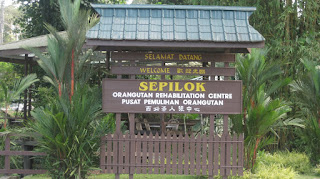The centre opened in 1964 as the first official orangutan rehabilitation project for rescued orphaned baby orangutans from logging sites, plantations, illegal hunting or kept as pets.[1] The orphaned orangutans are trained to survive again in the wild and are released as soon as they are ready. The sanctuary is located within the Kabili-Sepilok Forest Reserve which covers an area of 5529 ha, much of which is virgin rainforest.[2] Today around 60 to 80 orangutans are living free in the reserve.[3] It has become one of Sabah's top tourist attractions
The Sepilok Orangutan Rehabilitation Centre was established in 1964 to return orphaned "apes back to the wild. The centre was being administered by the wildlife section of the Forestry Department which in 1988 was upgraded as a department under the Ministry of Tourism and Environmental Development. All administration and management was given to the new Wildlife Department of Sabah.
The objectives of the project have expanded in recent years. While Orangutan rehabilitation is stilt the primary goal at Sepilok, present aims include public education on conservation, research and assistance to other endangered species such as captive breeding of the rare and endangered rhinoceros
This centre is now under the supervision of more than 37 staff, including a Wildlife Officer who is also officer-in-charge of the centre, a veterinary doctor, wildlife rangers and general workers.
The centre has a reception centre, information centre, offices for wildlife staff, an animal clinic, quarantine area and enclosures for various animals such as the rhinoceros.
Sepilok, renowned for its orangutan rehabilitation project, has stimulated a greater local and international awareness of the protection laws for endangered species, and the Centre has resulted in an increase in detection and confiscation of illegally held captive animals.
The Sabah Orangutan Rehabilitation Project was originally proposed in 1961 by P.F. Burgess, then the Deputy Conservator of Forests. He was also responsible for the establishment of a game branch within the Forest Department and the drafting of the Fauna Conservation Ordinance, 1963.
Soon afterwards, Barbara Harrisson, wife of the Curator of Sarawak Museum, began to rescue young orangutans being kept locally as pets, and the idea grew of training these animals to fend for themselves so that they might re-adapt to life in the wild. In 1962, with the backing of the newly formed World Wildlife Fund, Harrisson visited Sabah (then North Borneo) and reported that orangutan were rare and threatened with extinction. In Sabah it is a totally protected animal under the Fauna Conservation Ordinance, 1963











No comments:
Post a Comment